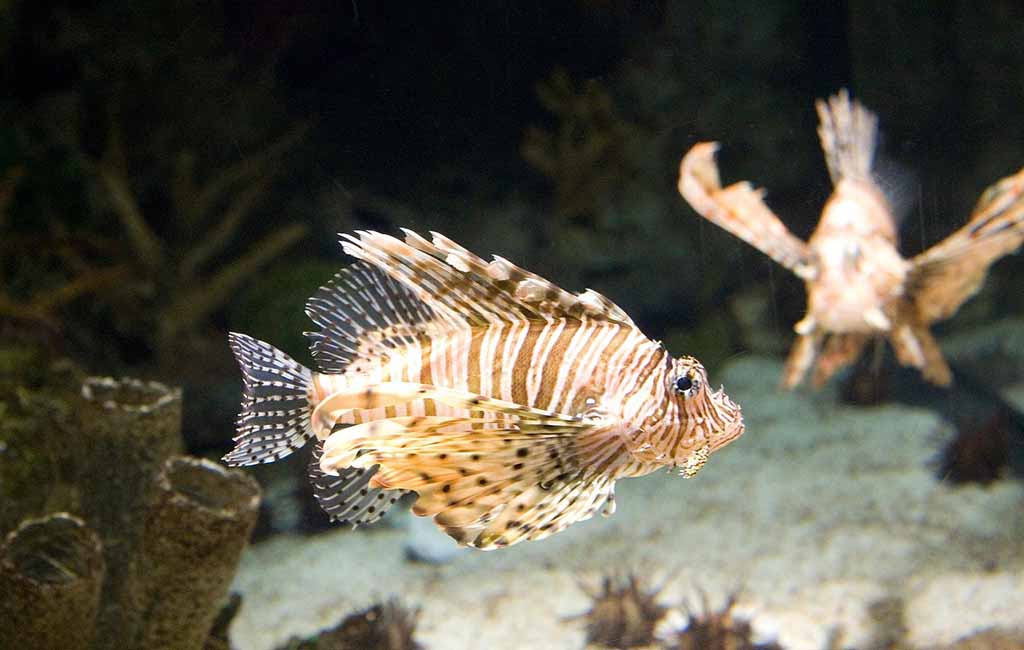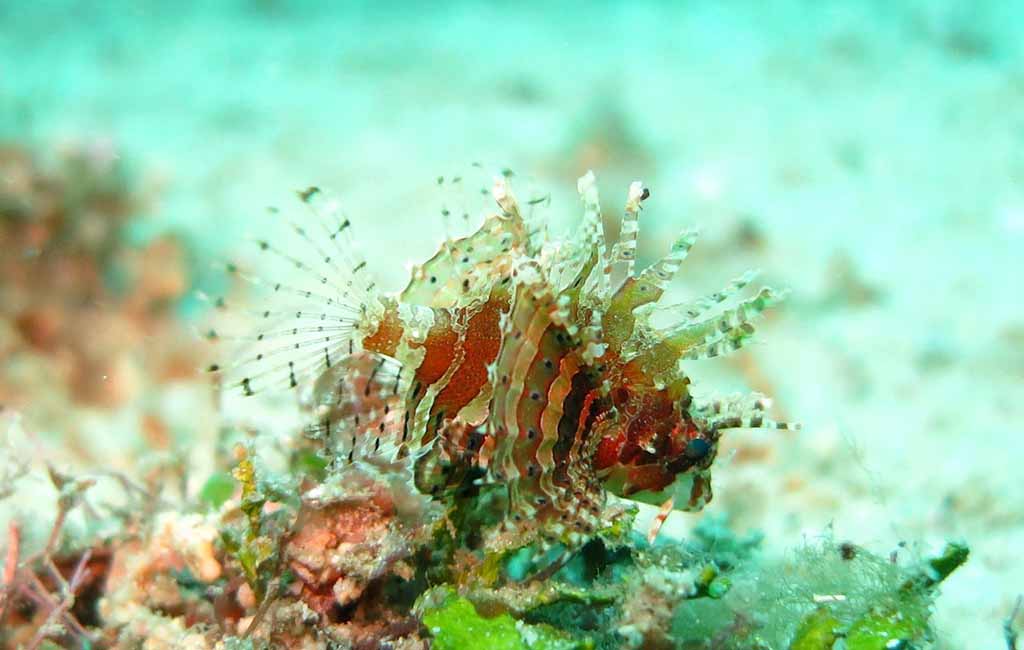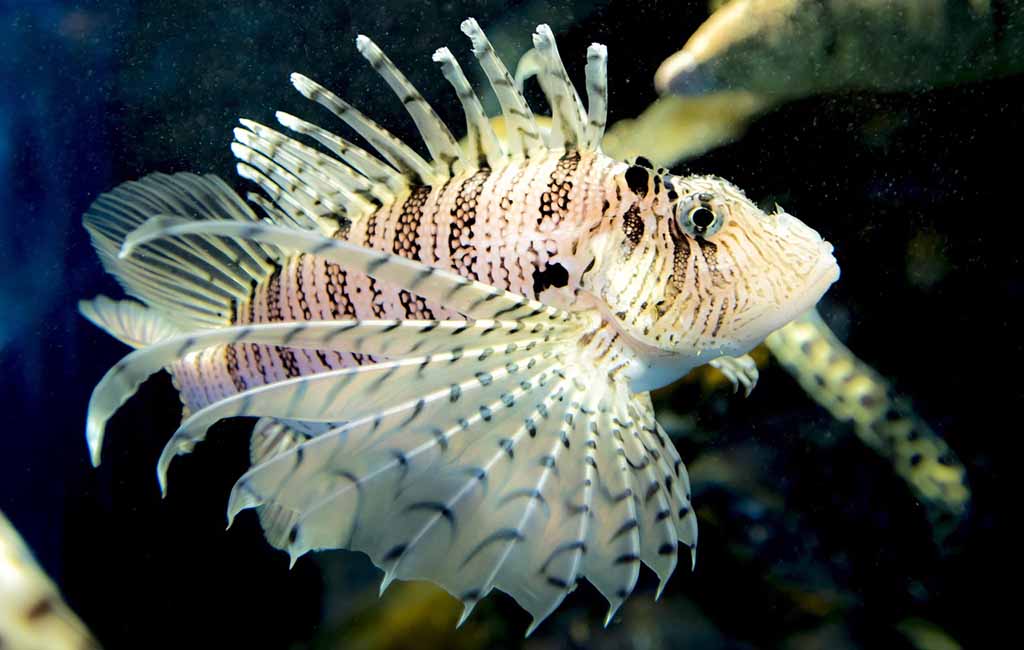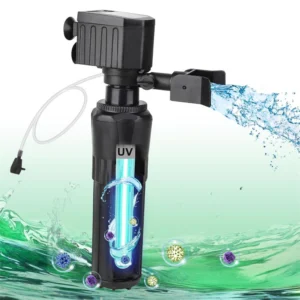Lionfish care is hard as they are venomous and have many other limitations. However, if you are an experienced aquarist and want to add striking coloration fish to your aquarium, go for it. You must know about lionfish tank size, tank mates, and how to care for a lionfish. In the following, you will all learn about them.
Content Table
If There Is a Lionfish in Your Tank
Yes, you can keep Ostentatious lionfish in your tank as a pet. Lionfish are eye-catching and have striking coloration. However, you can keep it under some conditions. Here is the conditions brief.
- You must have a large tank, i.e., at least 55 gallons for dwarf species and 100+ for large species.
- Never keep them with small or peaceful fish species, as they are predators.
- They are venomous, so handle them with great care and caution. Therefore, they are suitable for experienced aquarists.
- Check the legal status, i.e., whether you can keep them, as they are banned in some areas.

lionfish care
Lionfish Living Environment
Natural Living Environment
They are abundantly available in their natural habitat. It is estimated that there are about 200 adults per acre in the invasive regions. Here, you will find their natural habitat and preferred living conditions.
Natural Habitat Range
Lionfish inhabit the Indo-Pacific Ocean. They live in the South Pacific region. They are naturally available from Western Australia to Japan, Indonesia, and its surroundings. However, they are becoming invasive nowadays. You can find them in the western Atlantic, the Gulf of Mexico, and the Caribbean Sea.
Natural Living Conditions
You can find them in warm and tropical regions. They live around the coral reefs, shipwrecks, and rocky crevices at depths ranging from 0 to 300 meters. However, they are adapting to new living conditions. They are making oyster reefs, mudflats, seagrass beds, and mangrove communities their homes.
Aquarium Living Conditions
As you learned, you can keep them in your tank. Here are the living parameters of this marine beauty.
| Parameter | Value |
| Temperature | 74 – 80°F |
| pH | 7.9 – 8.3 |
| Salinity | 1.020 – 1.025 |
| Nitrate | Less than 50 mg/L |
| Nitrite and Ammonia | 0 |
| Carbonate Hardness | 8-12°dkH |
| Calcium | 380-450 ppm |
| Magnesium | 1250-1350 ppm |
Primarily Foods for Lionfish
Lionfish are primarily carnivorous. They feed on a variety of fish and invertebrates. More precisely, they love to consume smaller fish, crabs, and juvenile shrimps. They can even eat the living organisms that are part of their body. They are cannibals, i.e., they eat other lionfish, especially juvenile lionfish.

how to care for a lionfish
To Properly Care for a Lionfish
Lionfish have zebra-like stripes with a long venomous dorsal spine. They are beautiful and captivating. However, they require specific care and handling. Here is an overview of lionfish care.
Characteristics
| Feature | Explanation |
| Difficulty | Intermediate |
| Life | On average, 10 years |
| Size | 7 to 15+ inches. |
| 7 for dwarf species | |
| 15+ for large species | |
| Dietary preference | Carnivores |
| Tank size | 55 gallons for dwarfs |
| 100+ gallons for large species |
Tank Mates
They are carnivores. Therefore, keeping every species with them is unsuitable as they can eat them. Lionfish can even feast on their species, i.e., juveniles. Here are suitable tank mates that you can keep with them.
| Large marine anglefsih | Butterfly fish | Groupers |
| Foxface or Rabbitfish | Tangs |
Moreover, research on the species before adding it to the tank. Some lionfish species prefer to live socially, and some species, e.g., Fu Manchu, are suitable solo.
Filtration
Use a canister filter or power filter in the lionfish tank due to its large size. The filter should process the water 4 times to the total volume of the water in an hour. For example, if your tank has a 100-gallon volume of water. The filter should filter at least 400 gallons per hour. Don’t forget to install a protein skimmer to maintain the water quality.
Water Quality
Regularly check the water parameters, i.e., temperature, pH, ammonia, nitrite, and nitrate levels. As previously mentioned, the span was narrow and optimal. However, you can keep it between 74 – 80°F. However, do not allow to fluctuate the temperature more than 2°F in a day. They are marine species. Therefore, it is required to maintain a proper salinity level, i.e., 1.020–1.025. Use a hydrometer or refractometer for regular salinity checks in the tank.
Tank Setup
Use 1 to 2 inches of deep, soft sand or crushed coral substrate. However, don’t use gravel, as it can hurt lionfish. Install rocks, caves, and crevices as decor in your tank. These decor will help you to hide and give a natural habitat vibe.
Feeding
Use frozen and fresh food to feed your lionfish. Usually, their feed includes silversides, krill, and squids. Feed them once or twice daily. Always feed such a quantity that they can consume within 1 to 2 minutes. After that, remove the leftover food to maintain the water quality in the tank. They have a predatory nature. Therefore, feed them in a predatory style. Moreover, don’t feed completely frozen food. Also, avoid microwaved and refrozen food.
Tank Maintenance and Cleaning
Change 10 to 25% after 2 to 4 weeks in the tank. Use a fine mesh net to remove the leftover food. It’ll help you avoid any change in water parameters. Never go for a complete water change, as it can cause the removal of beneficial bacteria.
Clean the filter monthly for optimal filtration in the tank. Never use tap water, as it usually contains chlorine that is harmful to lionfish. If you want to use tap water, use a water conditioner before adding the tap water to the tank.
Health Condition
Keep a health check on your lionfish. Usually, a healthy fish has bright coloration, intact fins and spines, upright and regular swimming, and a large appetite. If you find any health signs missing, go for veterinary care. Usually, they fall into fin rot, saltwater ich, bacterial and fungal infections, and swim bladder disorder.

Lionfish Care Key Point
Lionfish Care Key Point
- Select the tank size according to their size, i.e., 29+ for juveniles, 55+ for dwarfs, and 120+ for large species.
- Keep a slow to medium water circulation.
- Secure the top with a lid to avoid escape.
- Maintain optimal water parameters in the tank.
- Use a water conditioner for tap water before adding it to the tank.
- Replace 10 to 25% water after every 2 to 4 weeks.
- Install a powerful filtration system and protein skimmer to maintain the water quality.
- Do regular water testing.
- Never group them with slow-moving and small species, as they can feast on their tank mates.
- Research on species before grouping, as some lionfish species prefer solo.
- Feed carnivorous food twice a day.
- Remove the food left over after 2 minutes with a mesh net.
- Consult the vet if you find any unusual signs in your fish.
Closing Remarks
Lionfish are beautiful marine species that are only suitable for experienced aquarists. They are venomous. Therefore, lionfish care is harder than easygoing species. However, as the above, you have learned how to care for your lionfish. It covered water parameters, suitable tank mates, food, precautions, etc. Do you have any lionfish? If you have, express your experience.


Leave a comment